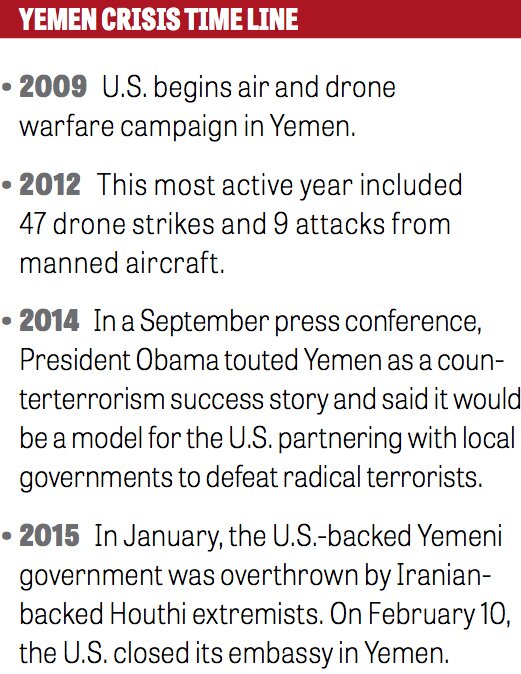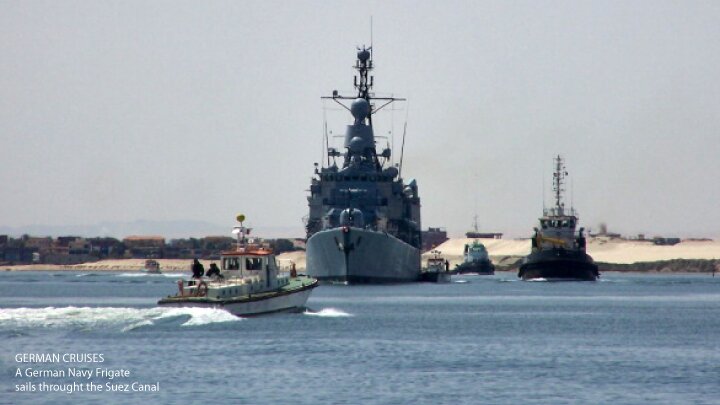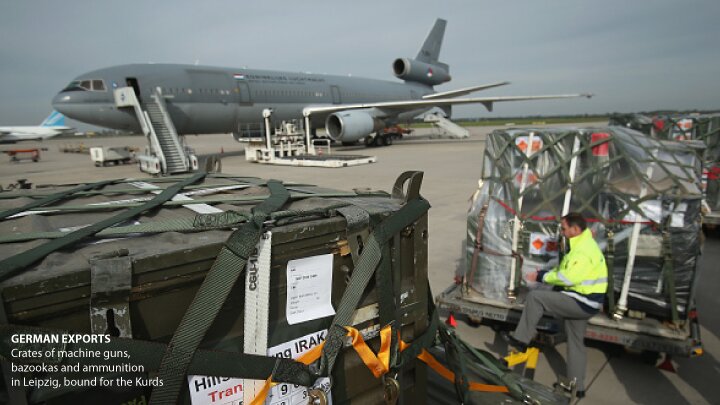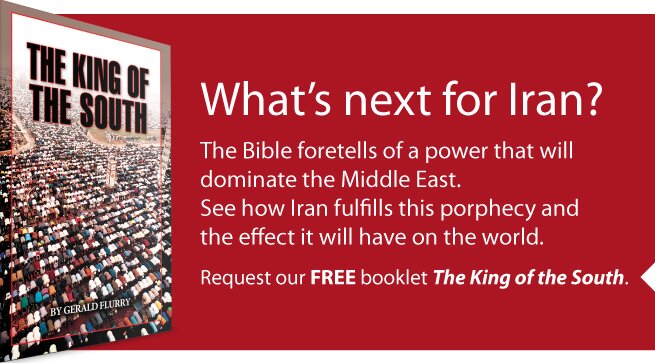Iran Gets a Stranglehold on the Middle East
Yemen is one of the most strategically important countries in the world. Recent developments there have shocked many people and will have dramatic effects that extend far beyond the Middle East.
In January, the Houthis, a rebel group sponsored and directed by Iran, overthrew the pro-American Yemeni government. After they conquered the capital city of Sanaa, throngs of Houthis began chanting “Death to America!” and “Death to Israel!” These are exactly the same battle cries that Iran uses.
This stunned many people in Europe and terrified many of the more moderate Arab states, especially those that rely on unlimited access to the Red Sea.
The Houthi takeover in Yemen proves that Iran is implementing a bold strategy to control the vital sea lane from the Indian Ocean to the Mediterranean Sea.
We need to understand the gravity of this new situation in Yemen!
In order to reach the Mediterranean Sea from the Indian Ocean, a lot of seafaring trade—including 3.8 million barrels of oil per day—passes through the Bab el-Mandeb Strait, the southern gate of the Red Sea. Measuring just 18 miles across, this channel is the closest point between the two landmasses of central Africa and the Arabian Peninsula. The northeast edge of the strait is in Yemeni territory.
The strategic importance of controlling this passage is equal to controlling the Suez Canal, since both are part of the same thoroughfare.
Consider the global ramifications: Nearly 10 percent of global seaborne oil supplies pass through the gates of the Red Sea. Roughly 20,000 ships pass through the Suez Canal and Bab el-Mandeb each year—an average of 55 per day. About 15 percent of global maritime trade travels through the Red Sea.
Now that Iran controls Yemen, it can virtually close or open this spigot on Middle East oil bound for Europe. And Europe is taking notice!
Historical Role of the Red Sea
By linking the Mediterranean Sea to the Indian Ocean, the Red Sea has always played a key role in world affairs.
From antiquity until the 15th century, the Red Sea acted as the main thoroughfare for east-west seafaring trade. Goods from the east were transported by ship through the Gulf of Aden, through the Bab el-Mandeb Strait, and into the Red Sea, continuing north toward the Gulf of Suez. Once these convoys made land, they transported the cargo north and west toward Mediterranean ports, where goods were again loaded onto ships for transport to southern Europe.

However, when the Cape of Good Hope in southern Africa was discovered the 15th century, the Red Sea’s importance as a global trade route waned. Now that Africa could be circumnavigated, Portuguese and then Dutch sailors used powerful westerly winds to cut down on sailing time by taking the southern route toward Asia. With the invention of steam-powered ships, ocean traffic around the southern cape increased even more dramatically in the 19th century, and Red Sea ports lost much of their strategic value.
But then in 1869, the Suez Canal opened. Suddenly, the distance between European and Asian ports was slashed by half to two thirds. The distance between Kuwait and Liverpool was reduced from 13,500 miles around the Cape of Good Hope to about 7,000 miles via the Red Sea. The route from Singapore to Liverpool was also nearly cut in half. This reinvigorated the use of the Red Sea passage, causing a huge surge in shipping and trade.
The strategic value of the Red Sea increased further in the 1930s, when oil began to flow from the Persian Gulf to Europe and the United States.
Since then, oil has become a chief commodity driving economic growth and military preparedness around the world. Thus, ensuring stability in the Red Sea and its two gates—the Suez Canal and the Bab el-Mandeb Strait—became critical to global trade and economic activity—and for maintaining the peace of the world.
Yemeni Col. Hussain al-Yadoomi wrote for the usa War College in 1991, “One of the primary duties of the international community is to act as an alert guardian to ensure that the Bab el-Mandeb Strait is available to all navigation and at all times” (emphasis mine throughout).
Now, rather suddenly, Iran—the world’s greatest state sponsor of terrorism—has basically become the gatekeeper to this strategic asset. This really does threaten the peace of the world!
Western nations, led by Britain and the U.S., have tried to ensure that the Red Sea remained open by supporting relatively Western-friendly regimes in the Middle East such as Egypt, Saudi Arabia and Yemen. Of course, the drawback to such a policy is that in the volatile Middle East, governments can change as fast as the shifting sands. But for many decades, this policy of supporting certain Middle Eastern regimes—together with a strong naval presence in the Indian Ocean and Mediterranean Sea—worked. It kept the Red Sea open most of the time.
Today, the situation has changed radically. Britain is nowhere to be seen. And to its great shame, the United States is actually supporting the Iranian takeover of Yemen! You can read more about this in our article on page 6.
Iran’s Red Sea Strategy
The Houthis’ takeover of Yemen was not just a grassroots revolution. It was a part of a deliberate and calculated Iranian strategy to conquer the Red Sea. This strategy is revealed in a powerful prophecy in the biblical book of Daniel.
As astounding as it may sound, the Prophet Daniel foretold what just happened in Yemen! He even mentions names of individual nations along the Red Sea corridor that will be aligned with Iran.
Notice it: “And at the time of the end shall the king of the south push at him: and the king of the north shall come against him like a whirlwind, with chariots, and with horsemen, and with many ships; and he shall enter into the countries, and shall overflow and pass over” (Daniel 11:40). This is an end-time prophecy. It concerns the time we are living in right now, and it directly concerns these Middle Eastern nations.
For almost 25 years we have identified the king of the south as a radical Islamist power led by Iran, and the king of the north as a German-led European power. This prophecy reveals that the Iranian-led power will push at Europe. It may be that this push could take place in the very area of Yemen or the Gulf of Aden.
Notice what Michael Segall wrote for the Jerusalem Center for Public Affairs: “If the Shia rebels gain control of the Bab el-Mandeb Strait, Iran can attain a foothold in this sensitive region, giving access to the Red Sea and the Suez Canal, a cause of concern not only for its sworn rivals Saudi Arabia, Egypt and the Gulf states, but also for Israel and European countries along the Mediterranean. Arab commentators in the Gulf have warned in recent years about this Iranian push” (Nov. 3, 2014).

While Arab commentators may have speculated about this Iranian push in recent years, we have warned about this push for almost a quarter century! Taking over Yemen puts Iran in an even stronger position to make this push.
The following verses in Daniel reveal other nations that will align with Iran, the king of the south. Those mentioned include Egypt, Ethiopia and Libya (verses 42-43). These nations are all situated next to the Mediterranean Sea or the Red Sea. In April 2011, I wrote that these nations are “the key that unlocks the strategy of radical Islam. … They are on the two seas that comprise the most important trade route in the world! Whoever heavily influences or controls Ethiopia will undoubtedly also control the small areas of Eritrea and Djibouti on the Red Sea coastline. These areas only recently became independent of Ethiopia. Also, I believe the Bible view is that these small areas are included as a part of Ethiopia.” (My booklet Libya and Ethiopia in Prophecy explains all this in detail. Read it online or request a printed copy; all of our literature is free.)
Recent reports also indicate that Iran has established itself in Eritrea. A January 27 Breitbart News report said Egyptian intelligence has found a secret Iranian base built “at the port of Assab in Eritrea on the Red Sea.”
Look at a map. Yemen is just a short 18 miles across the water to Eritrea, which was a part of Ethiopia until as recently as 1994. Controlling these nations could give Iran virtual control of the trade through these seas!
As I wrote in 2011, “Radical Islam could stop the flow of essential oil to the U.S. and Europe.”
It is not far-fetched to envision Iran using its power to control the flow of oil out of the Middle East. The supreme leader of Iran, Ayatollah Khamenei, has threatened as much. And on January 17, the Iranian state-sponsored Tasnim News Agency published an article that said boldly: “Today, all the arteries of oil transport—from Bab el-Mandeb Strait to Suez Canal and the Strait of Hormuz—are under Iranian control, by means of Syria, Yemen and Bahrain, and within range of Iranian missiles” (translation memri).
Iran is aggressively securing its foreign holdings along the Red Sea—and boasting about how it could use them!
Yet the United States is apparently allowing Iran free course in an effort to win it over in nuclear negotiations.
Many commentators recognize what this takeover in Yemen reveals about Iran’s overarching strategy in the Middle East.
Syndicated columnist Charles Krauthammer said this in an interview with Fox News: “Now, it’s true that the Houthis are against al Qaeda, but the real issue is that the Houthis are a client of, supported by, and in some ways advised by Iran. And as you saw on the map, the Saudis are looking at the Iranians in the north, the Iranian allies—which is essentially Iraq, Syria and Lebanon on one side and Yemen now—to the south and west under Iranian dominance, and they are scared to death. That’s why this is a double attack on us. It’s the loss of an ally against al Qaeda, and it’s a huge geopolitical gain for Iran, extending its influence over Arab states.”

He and others are sounding the alarm about Iran’s growing hegemony in the Middle East. But what these analysts and commentators do not see is where this situation is ultimately leading. We need Bible prophecy for that.
How It Will End
Daniel 11:40 shows that as these events play out with Iran, the United States won’t be a factor! It is Europe that Iran is going to push against. And it is Europe that will respond.
A European superpower is rising on the scene that will have the boldness and the power to deal with Iran’s pushing.
Europe is very worried about what Iran just did in Yemen. And unlike America, this European power will act!
Daniel 11:40 says Europe will come at Iran like a whirlwind. Gesenius’ Hebrew-Chaldee Lexicon says the Hebrew word for whirlwind is “used of the commotion of a storm or a tempest; to sweep away in a storm.” Europe is going to throw everything it has at the Iranian-led radical Muslims and utterly defeat them!
That drama all starts with a push from Iran.
This is the same nation that is about to get the nuclear bomb. Iranian leaders and many of their people believe the 12th imam—their version of the Messiah—is about to return. They think his return can be hastened by creating violence and chaos. Several nations in this world have nuclear weapons—but only Iran has leaders who harbor such dangerous religious thinking! What will happen when they get nuclear weapons? What sort of nuclear chaos would they stir up if they thought it would cause their messiah to return? In the thrall of religious zealotry, they would not even care about their own destruction if they use a nuclear weapon!
But who is going to stand up to Iran? If no one will stand up to it today, when it does not yet have nuclear bombs, who will stand up to it when it actually has the bomb?
The Bible does reveal that finally, after being pushed too far, the European power will stand up to the king of the south.
However, this prophecy about Yemen, the king of the north and the king of the south has a wonderful conclusion.
Reading into chapter 12 of Daniel, which is still part of this prophetic vision, we see that this clash will lead to catastrophic world war—“a time of trouble, such as never was since there was a nation even to that same time” (verse 1). Many other Bible prophecies talk about this period. Jesus Christ described it as “great tribulation” (Matthew 24:21). This is the dramatic climax of this age of man—and once it is over, God will begin to intervene in world affairs in a powerful way.

Daniel 12:11 mentions an event toward the beginning of that “great tribulation,” when “the abomination that maketh desolate [is] set up.” Christ referred to this statement from Daniel in His famous Olivet prophecy (Matthew 24:15; Mark 13:14). He revealed that this “abomination” is actually “Jerusalem compassed with armies”—armies that are about to destroy the Holy City! (Luke 21:20). Putting all the prophecies together shows that these are the European armies of the king of the north after they have conquered the king of the south.
And notice the conclusion to Daniel 12:11: From the time that these armies are set up, “there shall be a thousand two hundred and ninety days.”
Think about that! This prophecy reveals we are getting to a time where you can actually start counting days until the Second Coming of Jesus Christ! These events in Yemen show that we are almost able to begin to count the days. It was all prophesied thousands of years ago, and now every bit of it is being fulfilled before your eyes. These events are going to end with Jesus Christ’s return to Earth!
